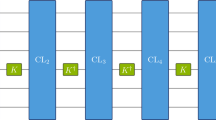Abstract
Given a universal gate set on two qubits, it is well known that applying random gates from the set to random pairs of qubits will eventually yield an approximately Haar-distributed unitary. However, this requires exponential time. We show that random circuits of only polynomial length will approximate the first and second moments of the Haar distribution, thus forming approximate 1- and 2-designs. Previous constructions required longer circuits and worked only for specific gate sets. As a corollary of our main result, we also improve previous bounds on the convergence rate of random walks on the Clifford group.
Similar content being viewed by others
References
Aaronson, S.: Quantum Copy-Protection. Talk at QIP, New Delhi, India, December 2007, available at http://www.scottaaronson.com/talks/copy.ppt, 2007
Abeyesinghe, A., Devetak, I., Hayden, P., Winter, A.: The mother of all protocols: Restructuring quantum information’s family tree. http://arxiv.org/abs/:quant-ph/0606225v1, 2006
Ambainis, A., Emerson, E.: Quantum t-designs: t-wise independence in the quantum world. IEEE Conference on Computational Complexity 2007, http://arxiv.org/abs/:quant-ph/0701126v2, 2007
Ambainis, A., Mosca, M., Tapp, A., de Wolf, R.: Private Quantum Channels. FOCS 2000, Washington, DC: IEEE, 2000, pp. 547–553
Ambainis, A., Smith, A.: Small pseudo-random families of matrices: derandomizing approximate quantum encryption. Lecture Notes in Computer Science 3122, Berlin-Heidelberg-NewYork: Springer, 2004, pp. 249–260
Arnold, V.I., Krylov, A.L.: Uniform distribution of points on a sphere and some ergodic properties of solutions of linear ordinary differential equations in a complex domain. Sov. Math. Dokl. 4(1), 1962
Barenco A., Berthiaume A., Deutsch D., Ekert A., Jozsa R., Macchiavello C.: Stabilization of quantum computations by symmetrization. SIAM J. Comput. 26(5), 1541–1557 (1997)
Barnum, H.: Information-disturbance tradeoff in quantum measurement on the uniform ensemble and on the mutually unbiased bases. http://arxiv.org/abs/:quant-ph/0205155v1, 2002
Dahlsten O.C.O., Oliveira R., Plenio M.B.: The emergence of typical entanglement in two-party random processes. J. Phys. A Math. Gen. 40, 8081–8108 (2007)
Dankert, C., Cleve, R., Emerson, J., Livine, E.: Exact and approximate unitary 2-designs: constructions and applications. http://arxiv.org/abs/:quant-ph/0606161v1, 2006
Devetak I., Junge M., King C., Ruskai M.B.: Multiplicativity of completely bounded p-norms implies a new additivity result. Commun. Math. Phys. 266, 37–63 (2006)
Diaconis P., Saloff-Coste L.: Comparison theorems for reversible markov chains. Ann. Appl. Probab. 3(3), 696–730 (1993)
Diaconis P., Saloff-Coste L.: Logarithmic Sobolev inequalities for finite Markov chains. Ann. Appl. Probab. 6(3), 695–750 (1996)
DiVincenzo D., Leung D., Terhal B.: Quantum data hiding. Information Theory. IEEE Transactions 48(3), 580–598 (2002)
Emerson J., Livine E., Lloyd S.: Convergence conditions for random quantum circuits. Phys. Rev. A 72, 060302 (2005)
Goodman R., Wallach N.: Representations and Invariants of the Classical Groups. Cambridge University Press, Cambridge (1998)
Grimmett G., Welsh D.: Probability: An Introduction. Oxford University Press, Oxford (1986)
Gross D., Audenaert K., Eisert J.: Evenly distributed unitaries: On the structure of unitary designs. J. Math. Phys. 48, 052104 (2007)
Hallgren, S., Harrow, A.W.: Superpolynomial speedups based on almost any quantum circuit. In: Proc. 35th Intl. Colloq. on Automate Languages an Programming LCUS 5125, 2, pp. 782–795, 2008
Hayashi A., Hashimoto T., Horibe M.: Reexamination of optimal quantum state estimation of pure states. Phys. Rev. A 72, 032325 (2006)
Hayden P., Horodecki M., Yard J., Winter A.: A decoupling approach to the quantum capacity. Open Syst. Inf. Dyn. 15, 7–19 (2008)
Hayden P., Preskill J.: Black holes as mirrors: quantum information in random subsystems. JHEP 09, 120 (2007)
Hoory, S., Brodsky, A.: Simple Permutations Mix Even Better. http://arxiv.org/abs/math/0411098v2[math.CO] 2004
Kitaev A.Yu., Shen A.H., Vyalyi M.N.: Classical and Quantum Computation. RI Amer. Math. Soc., Providence (2002)
Montenegro R., Tetali P.: Mathematical aspects of mixing times in Markov chains. Found. Trends Theor. Comput. Sci. 1(3), 237–354 (2006)
Oliveira R., Dahlsten O.C.O., Plenio M.B.: Efficient generation of generic entanglement. Phys. Rev. Lett. 98, 130502 (2007)
Paulsen V.I.: Completely Bounded Maps and Dilations. John Wiley & Sons, Inc., New York (1987)
Sen, P.: Random measurement bases, quantum state distinction and applications to the hidden subgroup problem. IEEE Conference on Computational Complexity 2006, 2005, pp. 274–287
Watrous J.: Notes on super-operator norms induced by Schatten norms. Quantum Information and Computation 5(1), 58–68 (2005)
Znidaric M.: Optimal two-qubit gate for generation of random bipartite entanglement. Phys. Rev. A 76, 012318 (2007)
Author information
Authors and Affiliations
Corresponding author
Additional information
Communicated by A. Connes
Rights and permissions
About this article
Cite this article
Harrow, A.W., Low, R.A. Random Quantum Circuits are Approximate 2-designs. Commun. Math. Phys. 291, 257–302 (2009). https://doi.org/10.1007/s00220-009-0873-6
Received:
Accepted:
Published:
Issue Date:
DOI: https://doi.org/10.1007/s00220-009-0873-6



